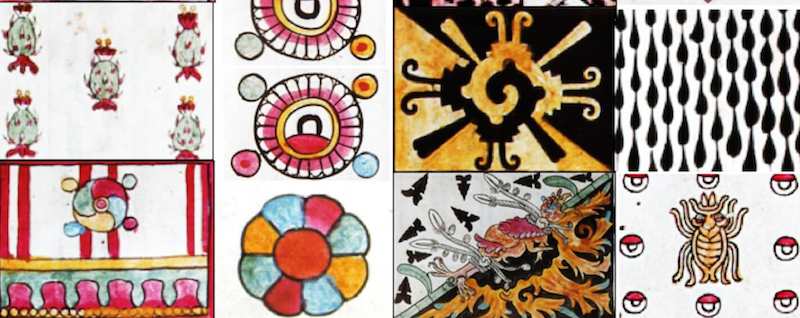Cosmic designs in prehispanic textiles
Textiles express a way of life, a way of being and a cosmogony. Textile art in Mexico is rooted in a remote and distant past. Long before the emergence of the first cities, the societies of ancient Mexico took advantage of several plants for the production of fibers and weaving their fabrics: lint from cotton seeds for soft fibers and maguey, palm and yuca leaves for hard fibers. They also took advantage of a great diversity of seeds, flowers, barks and roots as natural dyes and minerals as pigments, having a wide palette of beautiful colors: dark blue, black, intense reds (Brazil wood, cochineal) and also yellow, white, purple (from a mollusk), and green.
They developed tools and elaborate spinning and weaving techniques, achieving perfect mastery. First, they had to dominate the technique to transform the vegetables fibers into precious continuous threads. Then, they improved the magical act of interlace at right angles the longitudinal threads (the warp) with the transversal one (the weft). In the ancient times, the interweave of opposing forces symbolized life itself, movement, the circulation of energies. That is why the art of weaving appeared as a metaphor for the path of life and destiny.

The art of weaving was transmitted from mother to daughter. The weavers had their own tools, in particular the spindle, called malacate – to spin – and the back-strap loom and swords of the loom, called machetes - to weave. And at their death, they were buried with their precious instruments. Beyond production for family needs, women contributed greatly to the economy, pieces of fabrics being one of the main goods of exchange or tribute. There are valuable records from the early colonial period, such as the Codex Mendoza where it is mentioned that every 80 days (approximately 4 times a year) twenty seven lordships from the current states of Guerrero, Morelos, Oaxaca and Veracruz, delivered 32,400 pieces as tribute to the great city of Mexico Tenochtitlan. This enlightens us on the magnitude of the textile industry in prehispanic times! The weavers perfectly mastered a vast variety of ligaments fabrics such as taffeta, tapestry, brocade, embroidery, etc - and also made complex designs.
Most of the fabrics production were garments. Standard cuts prevailed. Men wore a two-piece suit: a loincloth called maxtlatl, one-piece garment which covers the genitals, and a cloak knotted over the right shoulder and that slipped on different parts of the body depending on the circumstances. The women wore skirts, called cueitl, fixed with a belt, tunics called huipilli, that consist of a rectangular cloth, folded in half, with an opening for the head and tip neck. All of them were adorned with majestic embroidery designs. The huipil remains a masterpiece.

The hard fibers - and at the same time more resistant - were for common people, the (macehualtin), while the cotton was reserved for the noble lords (pipiltin) and the hierarchies of higher command.
There is a great variety of incredible designs made in brocades (directly on the fabrics) or embroidery of precious materials such as fine threads, rabbit hair or feathers. Only a very few Haute Couture houses can today compete in techniques and art.
They beautified their costumes with headdresses and many accessories such as ear ornaments, necklaces, nose rings, bracelets, and used makeup, tattoos, dental incrustations, etc. which defined status, beauty, identities, beliefs and fashions.
The cultures of ancient Mexico were extraordinarily skilled in the weaving art and particularly creative in the composition of designs. There are several records made in the years after the Conquest. First, because in their thirst for evangelization, the missionaries compiled the old knowledge and secondly because the Spanish administration ordered copies of the Aztec tribute records. The designs on the clothes used during the ceremonies represent cosmic and cosmogonic symbols, related to forces, gods, goddesses, and myths of creation, full of divine and invisible powers.

About our Author:
Marion Du Bron, Founder of DestinationMEX
 Historian PhD, School of High Social Sciences Studies (EHESS), Paris.
Historian PhD, School of High Social Sciences Studies (EHESS), Paris.
She has lived in Mexico since 2003.
Unconditionally passionate for Mexican history and culture.
Entrepreneur and coach for foreigners.



0 comments